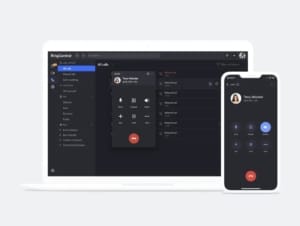Today, on global accessibility awareness day, we are educating ourselves on technology accessibility. We’ll take a look at why it’s crucial to our global economic and social success, the strides we have made to address accessibility for our users and the long road ahead, as we continue to innovate.
What is accessibility?
To understand what we mean by accessibility, let’s try experiencing inaccessibility for a moment. Turn off your computer monitor and start typing. Use your phone from under a table where you can’t see it. Unplug your mouse and try to navigate your company website. Set the screen zoom in (magnifying glass) level on your Google browser to 500%, limiting the amount of content you can see at any one time. Unplug your speakers and watch a webinar without sound. Get the picture?
Accessibility means that everyone has access to the exact same technology as anyone else – regardless of whether they can use a mouse, how much vision they have, how many colours they can see, how much they can hear or how they process information.
Access by Design
Now you might be wondering how accessibility technology helps people with disabilities. How does it help them operate mobile phones or tablets? The answer is that accessible technology is designed with these capabilities in mind. Accessible technology adds layers into the software, mobile apps and more to allow people with disabilities to access the same information as everyone else.
What’s exciting about today is that the technology landscape is evolving right in front of our eyes. From AI to voice-enabled technology, the revolution is impacting every industry to make tools accessible and adaptive. Let’s take a look at seven advancements in accessible tech to show you where the industry is heading.
Voice-powered technology
The buzz-worthy topic that’s taken the world by storm, voice-powered technology.
Speech recognition
Speech recognition technology works with a mobile, computer or smart home device. For someone with severe dyslexia, if they’re trying to write down three ideas and they can only speak (to their phone or smart home device), it will take note of all three ideas. . Speech recognition has given all the ability to express knowledge and understanding to a greater extent.
Smart home device adoption
Smart home tech adoption is rising within the disabled community. These personal smart devices (Alexa, Google Home, etc) are becoming a staple for households globally. It’s incredibly powerful for people with disabilities.
Find out about RingCentral’s Alexa integration here. Find out about RingCentral’s integrations with Google here.
Interactive voice-powered web pages
Voice powered web pages are the future of web browsing. We have only touched the surface of controlling our laptops or desktops with our voices. The rising popularity of chatbots is merely a precursor to the forthcoming pervasiveness of VoiceBots. In the not so distant future, businesses will use VoiceBots to connect, qualify and engage their website visitors through personal conversations. This will also make their website more accessible for any type of customer, broadening their total addressable market to those with disabilities.
VoiceBots allow website visitors to navigate companies’ websites and obtain the information without having to type or read. They also give companies more control over their brand identity and are helping companies learn about their visitors by capturing actionable data otherwise impossible to obtain through text. Web pages interacting with end-users with voice technology is going to be the future of accessible web advancement.
For example, you can listen to this blog via audio recording at the top of the page – scroll up!
Keyboard accessibility
Keyboards are a vital component of web accessibility. A user that is blind, has motor disabilities, tremors, little or no use of their hands or doesn’t have hands, must still rely on a keyboard for navigation and to access content. Lack of keyboard accessibility was ranked fifth in the list of most problematic accessibility items to disabled users in a WebAim survey of over 1,000 participants. Approximately 11% (10.9%) of respondents with disabilities said keyboard accessibility was their single most problematic area.
The emergence of on-screen keyboards
On-screen keyboard: A non-physical keyboard for those who can’t access a standard or accessible keyboard. Some can be accessed by a mouse, switch or eye gaze.
Accessible keyboard breakthrough: Tap and wearable keyboards

Recent developments have added yet another option for those seeking an accessible keyboard. A tap keyboard fits around the user’s fingers, which is connected through five rings and only requires limited finger movement and the use of one hand. Tap keyboards transform any surface into a keyboard you can ‘type’ on.
For someone who only has the use of one hand, a tap keyboard is a much more sensible ergonomic option than a one-handed keyboard.
Learn about RingCentral’s keyboard accessibility features here.
Closed captions and transcriptions
Whether participants are hearing-impaired, have different levels of language proficiency or are joining from a noisy area, video meetings should be accessible for everyone. That’s why RingCentral launched closed captioning. The new tool automatically converts spoken words into captions in real time and populates them in a new section above the menu bar. Every participant is also able to enable and disable this feature individually.
Why you should try it
- Hearing-impaired: Those who are deaf or hard of hearing can read the captions to follow the conversation.
- Language proficiency: If a conversation moves too quickly, participants can use captions to stay on track.
- Noisy areas: When you can’t drown out background noises, enable captions and never miss a word.
Learn how to enable closed captions on your RingCentral app here.
Screen readers
A screen reader is a software feature integrated directly into a computer’s operating system or an app. The screen reader converts text-to-speech and provides a computerised voice over that scans and reads web pages for the user.
Advances in screen reader technology have been more impactful for blind users than anything else we’ve done in development and design. These innovations are getting better with every release we do. Especially for like ARIA and dynamic content.
A great example of this in practice is our recent story with the CNIB Foundation (Canadian National Institute for the Blind), Canada’s oldest and largest organisation serving people with sight loss. The switch to modern communications was challenging because there are not many technology solutions that cater to people with sight loss. Features such as screen magnification, screen reading and keyboard-controlled hot keys are essential to CNIB Foundation’s workforce, as 20% are people with sight loss. They selected RingCentral to seamlessly switch from desktop to mobile, making it easy for those who are blind or partially sighted to work from anywhere. With the organisation’s mission to enable people impacted by blindness to “live the lives they choose”, RingCentral was the right technology fit.
Read about accessibility support for low vision or blind users for RingCentral apps here.
Artificial intelligence
Every industry is implementing artificial intelligence and machine learning in one way or another.. One specific area we would love to see AI and machine learning address is in the evaluation and assessment of accessible technology, websites and apps. It would be powerful for AI to assess where the gaps are, what issues need to be addressed and how to prioritise what to improve.
Ideally, we would use AI to look at huge amounts of data across the web to find patterns of accessibility so we can begin to prescribe solutions.Then we would look to fix some of those issues leveraging AI as well. We have enough knowledge about certain types of errors that always occur. But what if there were ways we could automatically address that?
The hope is to create a way for AI and machine learning to self-regulate different accessibility criteria and standards for a variety of platforms and correct them automatically. This removes the need for manual updates by developers. The biggest byproduct of this kind of innovation is that the baseline of quality accessible web content would dramatically improve. RingCentral is looking at this space intently, so stay tuned to our future releases to see if we uncover any breakthroughs.
Colour and high contrast themes
Many of us are now familiar with dark mode features on our favorite apps. We may find ourselves using Twitter’s dark mode at night because it’s easier on our eyes. Software and web application designers noticed that users like these options. This is in addition to an increased ability for users to customise a personal view or the view of published content.

High contrast settings benefit users with low vision or other visual disabilities. Relying on color alone to convey meaning is typically avoided because it can make content inaccessible to users who have color blindness, as well as users who are blind. While this accessibility principle is well known, there are also times when color can be used in a way that may only present problems to users who rely on high contrast.
Learn about RingCentral’s dark mode features and high contrast themes here.
Multi-line braille display
For decades, braille has been communicated to those with visual impairments on a single horizontal line. That means there are limits to how much and what kind of information can be communicated to a blind reader at one time. Many advanced STEM, tabular mathematical information and also braille music are not able to be read by a singular line of braille.
Bristol Braille Technology created a groundbreaking multi-line braille machine called the Canute. Dubbed the ‘Kindle for the blind,’ the affordable, multi-line braille e-reader can show nine lines of 40 characters (360 characters total). Most existing displays could do one line of 12-80 characters.
This technology will prove highly useful to blind readers looking for work in mathematic-heavy fields.If someone is blind and going into an engineering field or job where they use graphs, that technology is really evolving.
RingCentral invests in accessibility
People of all ages, cultures, socioeconomic groups and those with preconditions rely on the internet for a number of daily activities. It’s forever changed the way we learn, shop, socialise, work and apply for jobs. The success of a product – of an entire company – depends on its ability to reach all people and impact their lives. This is especially true in the world of technology, where connecting individuals on a global scale is priceless.
Accessibility is about making products work for all people. Specifically, being more accessible to people with a diverse range of hearing, movement, sight and cognitive abilities.
To learn more about our accessibility features please visit https://www.ringcentral.com/product-accessibility
Originally published May 20, 2021, updated May 21, 2021

